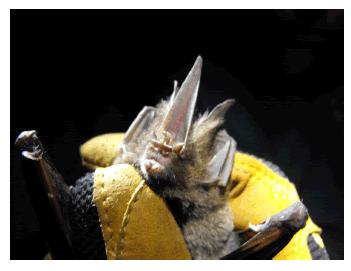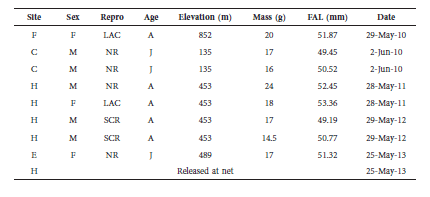Serviços Personalizados
Journal
Artigo
Indicadores
-
 Citado por SciELO
Citado por SciELO
Links relacionados
-
 Similares em
SciELO
Similares em
SciELO  uBio
uBio
Compartilhar
Mastozoología neotropical
versão impressa ISSN 0327-9383
Mastozool. neotrop. vol.21 no.2 Mendoza dez. 2014
NOTA
Captures of the tome's sword-nosed bat, Lonchorhina aurita (Chiroptera, Phyllostomidae), from Ometepe Island, Nicaragua, and range implications for this species
Phillip N. Jordan1, Patrick R. Moore1, Evan L. Pannkuk2, and Thomas S. Risch1
1 Department of Biological Sciences, Arkansas State University, State University, AR 72467, USA [Correspondence: Thomas S. Risch <trisch@astate.edu>].
2 Graduate Program of Environmental Science, Arkansas State University, State University, AR 72467, USA.
Recibido 6 junio 2014.
Aceptado 18 agosto 2014.
Editor asociado: P Velazco
ABSTRACT.
Lonchorhina aurita (Tome's sword-nosed bat) is a locally rare/restricted bat species distributed from the northerly ranges of Veracruz, Mexico to the South American countries of Brazil and Peru. Prior to our study on Ometepe Island, Nicaragua, this species was documented from a single individual from 1 location in Nicaragua (Matiguás, Matagalpa). During 2010-2013, a total of 9 L. aurita were captured in tropical interior forests and agricultural forests with dense upper and midstory vegetation. L. aurita were captured from several locations on Ometepe Island and included reproductive adults and juveniles. Our data suggest that a persistent L. aurita population is established on Ometepe Island.
RESUMEN.
Capturas del murciélago nariz de sable de Tomes, Lonchorhina aurita (Chiroptera, Phyllostomidae), en la isla de Ometepe, Nicaragua, e implicaciones para la distribución de esta especie.
Lonchorhina aurita (murciélago nariz de sable de Tomes) es una especie rara de murciélagos, restringida a localidades y distribuida desde el norte de Veracuz, en México, hasta Brasil y Perú. Antes de nuestro estudio en la Isla Ometepe de Nicaragua, esta especie solo había sido reportada en 1 localidad de Nicaragua (Matiguás, Matagalpa). Entre 2010 y 2013, se capturaron 9 L. aurita en bosques tropicales del interior y en estratos altos y medios de bosques agrícolas con vegetación densa. Los L. aurita fueron capturados en varios lugares de la Isla Ometepe, e incluyeron adultos en etapa reproductiva e individuos juveniles. Nuestros datos sugieren que una población persistente de L. aurita se ha establecido en la Isla Ometepe.
Key words: Bat fauna; Central America; Maderas; Nicaragua; Ometepe Island.
Palabras clave: América Central; Isla de Ometepe; Maderas; Murciélagos; Nicaragua.
Tome's sword-nosed bat, Lonchorhina aurita Tomes, 1863, is an insectivorous bat (Chiroptera: Phyllostomidae) found in mature forests and agricultural areas (Emmons and Feer, 1997; Lord, 2007; Reid, 2009; Fig. 1). It is medium sized (~18 g) for the Lonchorhina genus, as it is smaller than L. marinkellei Hernández- Camacho and Cadena-G., 1978, yet larger than L. orinocensis Linares and Ojasti, 1971 and L. fernandezi Ochoa and Ibáñez, 1984 (Lassieur and Wilson, 1989; Simmons, 2005). L. aurita gets its name from the striking lance-shaped nose leaf with a conspicuous longitudinal ridge. L. aurita ranges as far north as Chiapas, Mexico, through El Salvador, Costa Rica, Panama, Guyana, the islands of Tobago and Trinidad, Colombia, and Venezuela, and as far south as Bolivia, and southeastern Brazil (Williams and Genoways, 2008; Reid, 2009). One L. aurita was captured in the Bahamas, but was identified as an accidental occurrence (Buden, 1986). L. aurita is listed as Least Concern (Sampaio et al., 2008), and is uncommonly reported in Nicaragua (Medina et al., 2007). Colonies of up to 500 L. aurita have been reported in a single location (Bloedel, 1955), the first reported capture in Nicaragua was in 2003-2004 from one specimen (Medina et al., 2007; Fig. 2).

Fig. 1. Lonchorhina aurita (Tome's sword-nosed bat) captured on Ometepe Island, Nicaragua (28-May-11; Photo Credit: Thomas Risch).

Fig. 2. Map of Ometepe Island capture locations of Lonchorhina aurita (Tome's sword-nosed bat) from 2010-2013. Stars represent successful L. aurita capture sites. Triangles indicate unsuccessful L. aurita capture sites. Inset, approximate location of country record (after Medina et al., 2007).
In this study, we captured bats on Ometepe Island, Nicaragua during the periods of late May-early June (2-week trips) in the years 2010-2013 (Table 1). Capture and releases were performed with assistance from the Ometepe Biological Research Station, which is a part of the Maderas Rainforest Conservancy (www.maderasrfc.org). Ometepe Island is ~276 km2 and includes 2 volcanos, Maderas and Concepción. Netting occurred primarily on Maderas, which is ~1400 m in elevation and provides bat habitats from lowland dry forests, orchard mid-level forests, open waterfalls, and tropical interior forests with dense upper and mid-story vegetation. Netting also occurred on the isthmus between Maderas and Concepción.
Table 1. Captures of Tome's sword-nosed bats, Lonchorhina aurita, on Ometepe Island, Nicaragua. FAL = forearm length, Repro = reproductive condition, LAC = lactating, NR = non-reproductive, SCR = scrotal; sites correspond to letters on Fig. 4.

Lonchorhina aurita was captured in 4 separate locations (Fig. 2) using mist nets (open waterfall/rock [9 x 8 m], tropical interior forest [6 x 3 m], footpath in mature tropical forest [9 x 8 m], and mid-level forests [4 x 8 m]). One capture was at an elevation of 852 m, 50 m from San Ramon Waterfall. Four were captured on private property 50 m to the north of a water-powered electric plant at an elevation of 453 m, over a foot path. A juvenile was captured over a trail with elevation of 135 m. One bat caught in 2013 was released from the net to minimize distress to the animal due to heavy rains, inhibiting morphological data collection. The elevations (135-852 m) of bat captures are consistent with previous reports of L. aurita being captured at 375 m in Ecuador (Anthony, 1923) and specimens reported from 25-1537 m from the mammal collection at the National Museum of Natural History Collection (Lassieur and Wilson, 1989). All bats were captured in old-growth or secondary-growth forests. We netted orchards in the same manner resulting in no L. aurita captures. Reproduction has been reported to occur between the months of February-July (Lassieur and Wilson, 1989) within described range (Reid, 2009). We captured 2 lactating females, 2 scrotal males, 1 juvenile female, and 1 non-reproductive male. Our findings are consistent with previously reported reproductive seasons for L. aurita. These captures confirm that breeding populations of L. aurita are in southern Nicaragua during times stated by Lassieur and Wilson (1989).
Lonchorhina aurita is reported to be common in areas with high cave concentrations (Sampaio et al., 2008; Reid, 2009). Due to our captures of several reproductive adults and a juvenile L. aurita from different locations, our data suggest that a persistent population is established on Ometepe Island. Our data are consistent with the reported range of this species in Nicaragua (Martinez-Sánchez et al., 2000; Medina-Fitoria and Saldaña, 2012) and suggest that the range of this species may be more continuous in Central America than previously believed (Sampaio et al., 2008; Reid, 2009).
Acknowledgements.
We thank the Ometepe Biological Research Station, those involved in the Neotropical Bat Ecology Class from 2010-2013, especially Ryan Allen, Tracy Klotz, and Jessica Sewald for field assistance. Jose Tovar helped with Spanish translation and manuscript preparation. Partial funding was provided by the Department of Biological Sciences, Arkansas State University, Jonesboro, Arkansas, USA.
LITERATURE CITED
1. ANTHONY HE. 1923. Preliminary report on Ecuadorean mammals, No. 3. American Museum Novitates 55:1-14. [ Links ]
2. BLOEDEL P. 1955. Observations on the life histories of Panama bats. Journal of Mammalogy 36:232-235. [ Links ]
3. BUDEN DW. 1986. Distribution of mammals of the Bahamas. Florida Field Naturalist 14:53-84. [ Links ]
4. EMMONS LH and F FEER. 1997. Neotropical Rainforest Mammals: A Field Guide, 2nd ed. University of Chicago Press, Chicago, IL, USA. [ Links ]
5. LASSIEUR S and D WILSON. 1989. Lonchorhina aurita. Mammalian Species 347:1-4. [ Links ]
6. LORD RD. 2007. Mammals of South America. The John Hopkins Press, Baltimore, MD, USA. [ Links ]
7. MARTINEZ-SÁNCHEZ JC, S MORALES, and E CASTANEDA. 2000. Lista patrón de los mamíferos de Nicaragua. Primera edición, Fundación Cocibolca, Managua, Nicaragua. [ Links ]
8. MEDINA-FITORIA A and O SALDAÑA. 2012. Lista patrón de los mamíferos de Nicaragua. FUNDAR, Managua, Nicaragua. [ Links ]
9. MEDINA AR, CA HARVEY, DS MERLO, S VILCHEZ, and B HERNANDEZ. 2007. Bat diversity and movement in an agricultural landscape in Matiguás, Nicaragua. Biotropica 39:120-128. [ Links ]
10. REID F. 2009. A field guide to the mammals of Central America and southeast Mexico, 2nd ed. Oxford University Press, New York, USA. [ Links ]
11. SAMPAIO E, B LIM, S PETERS, B MILLER, AD CUARÓN, and PC DE GRAMMONT. 2008. Lonchorhina aurita. The IUCN Red List of Threatened Species. Version 2014.2. <www.iucnredlist.org>. Downloaded on 13 August 2014. [ Links ]
12. SIMMONS NB. 2005. Order Chiroptera. Pp. 312-529, in: Mammal Species of the World. A taxonomic and geographic reference, 3rd edition (DE Wilson and DM Reeder, eds.). Baltimore, The Johns Hopkins University Press. [ Links ]
13. WILLIAMS SL and HH GENOWAYS. 2008. Subfamily Phyllostominae Gray, 1825. Pp. 255-300, in: Mammals of South America, volume 1. Marsupials, xenarthrans, shrews, and bats (AL Gardner, ed.). University of Chicago Press, Chicago, Illinois. [Copyright 2007; published March 2008. [ Links ]]














